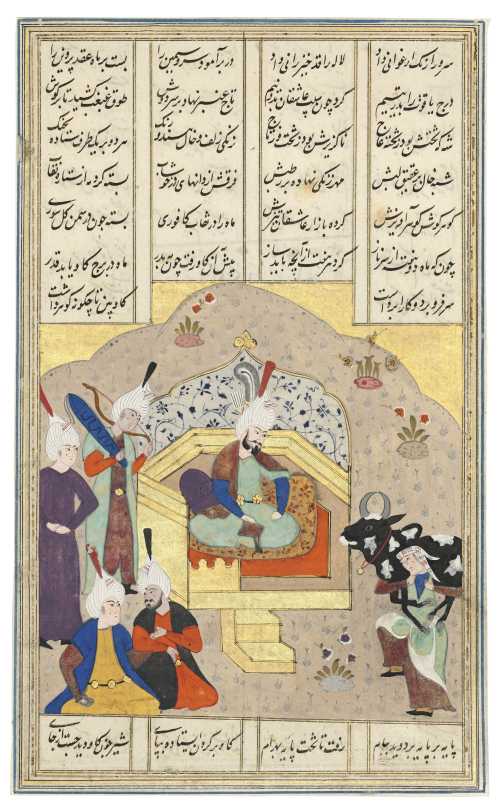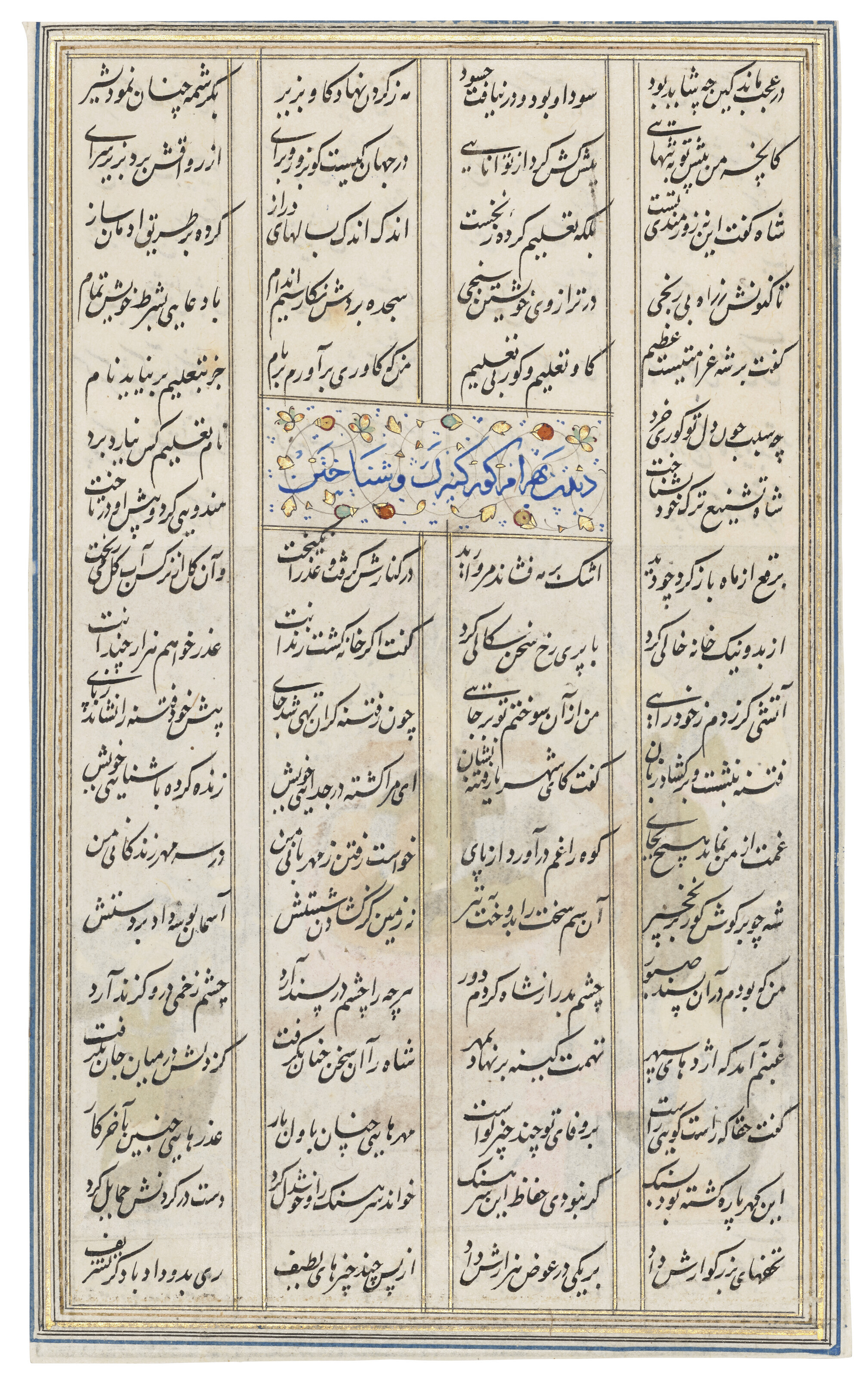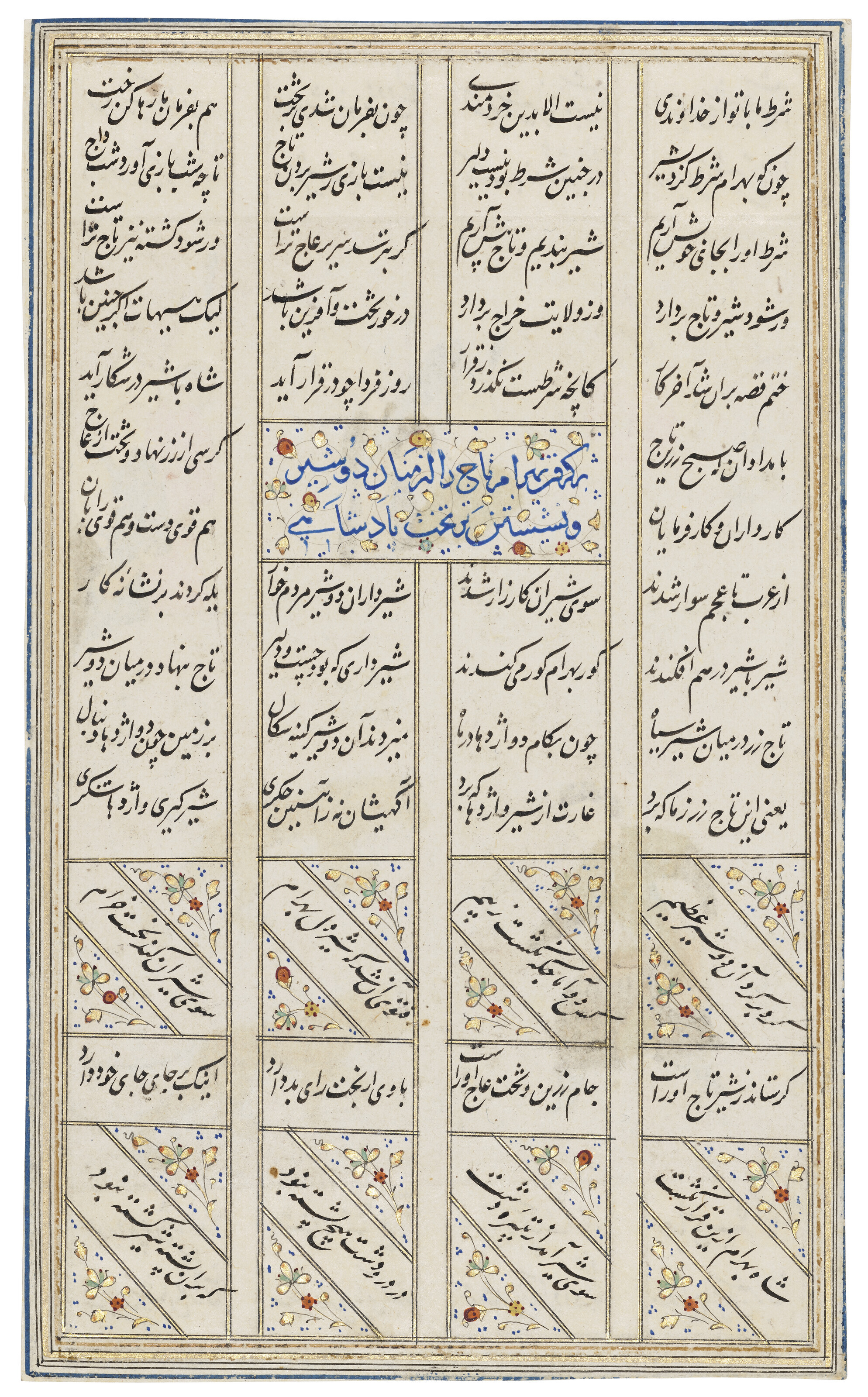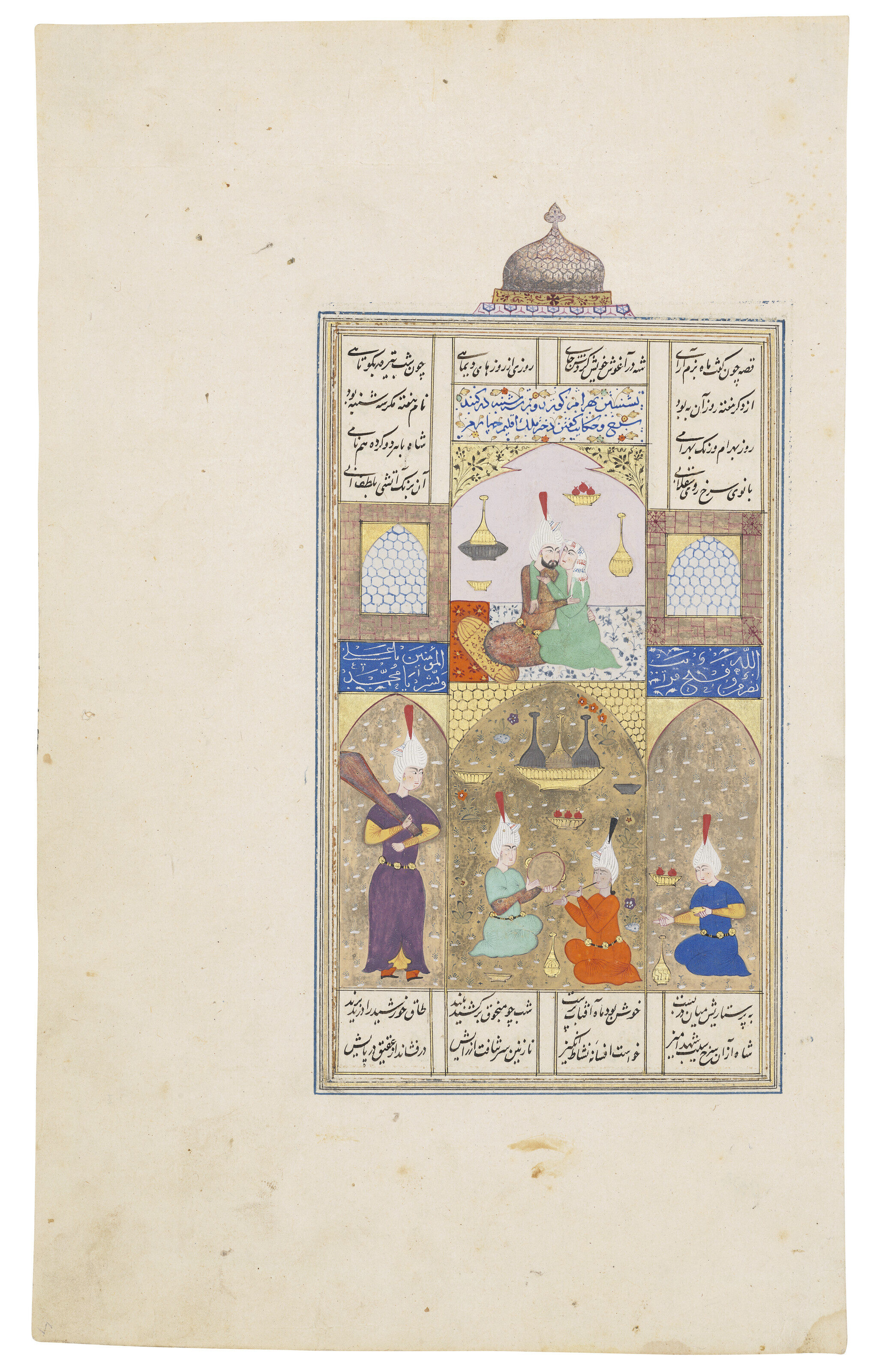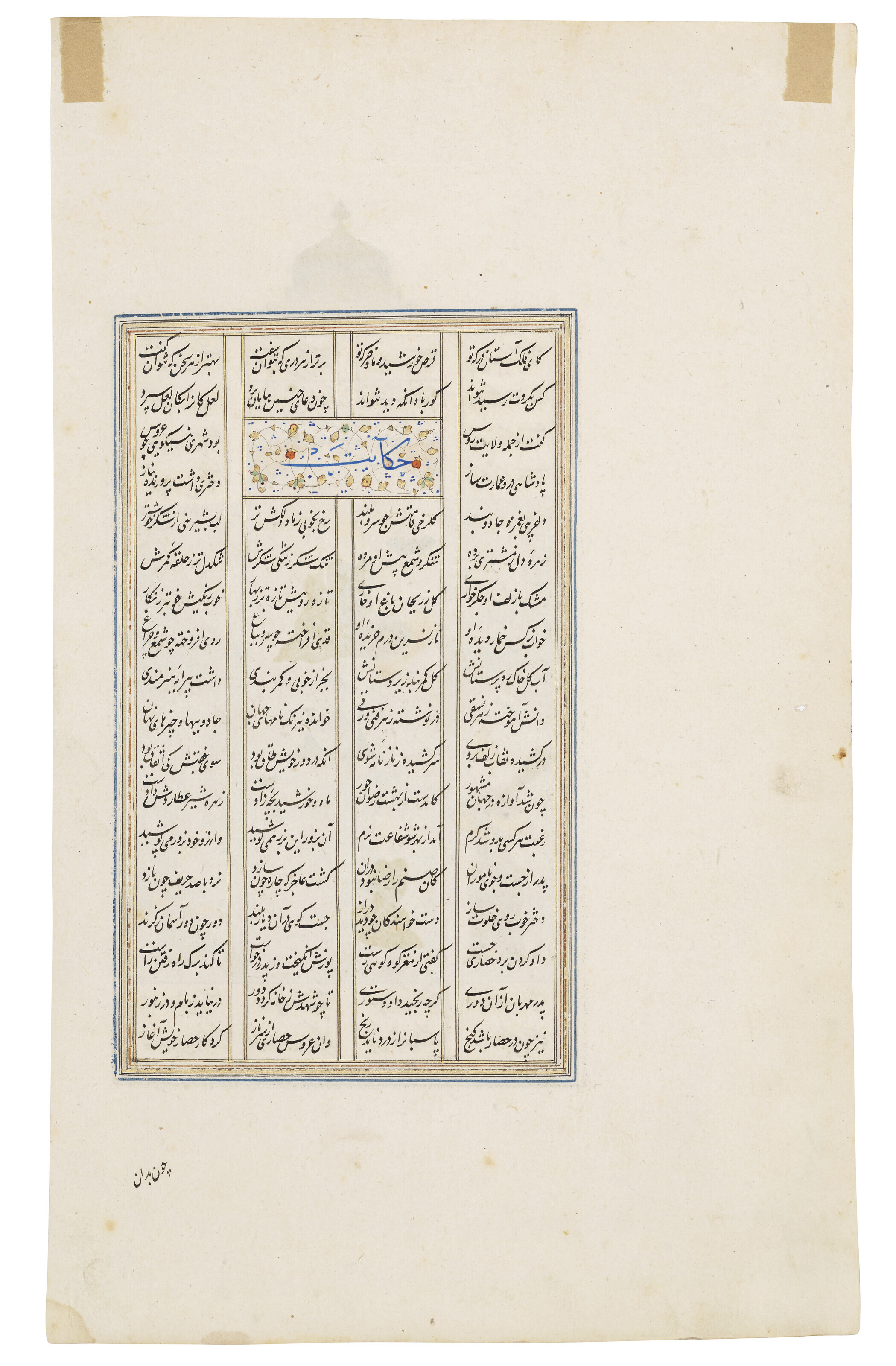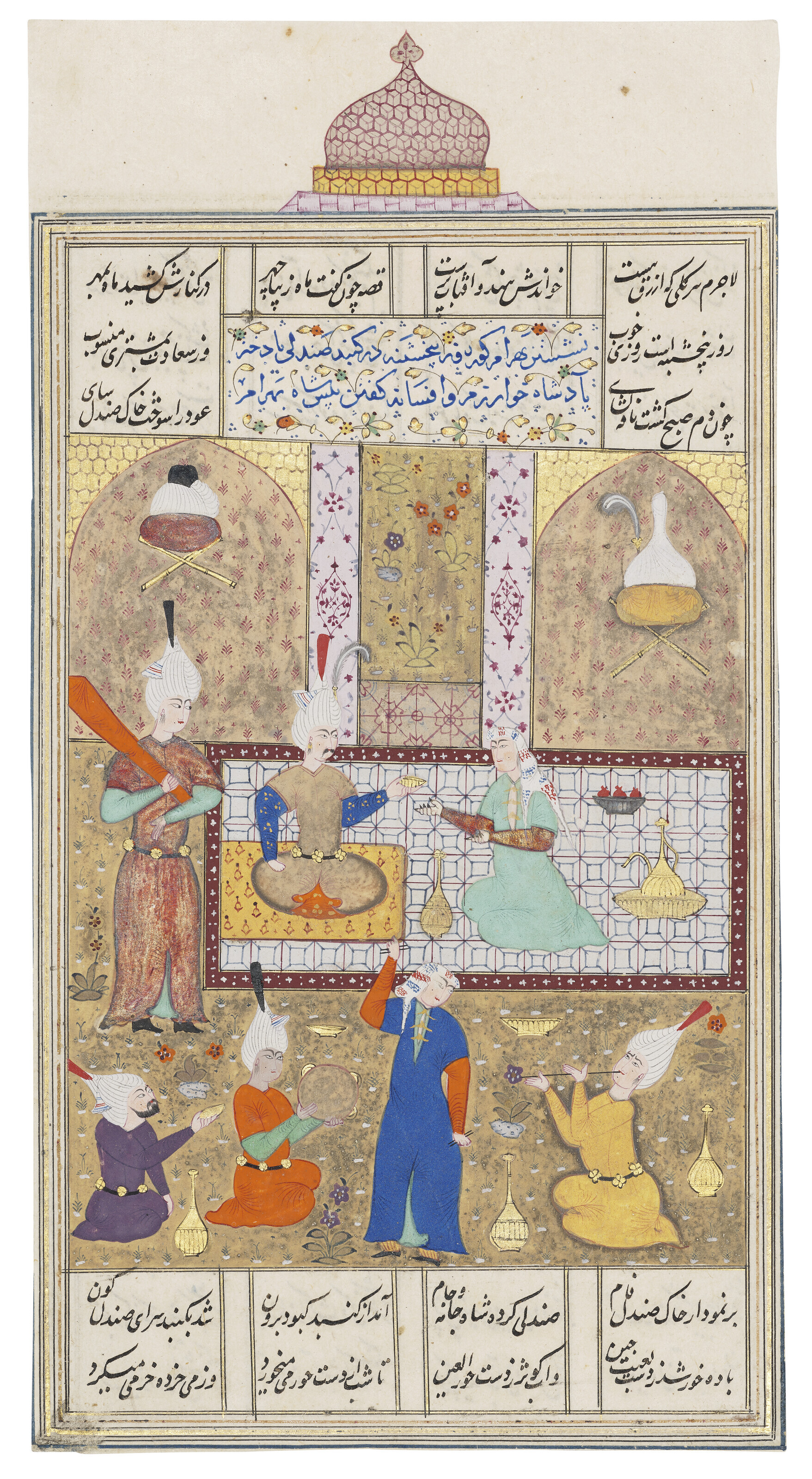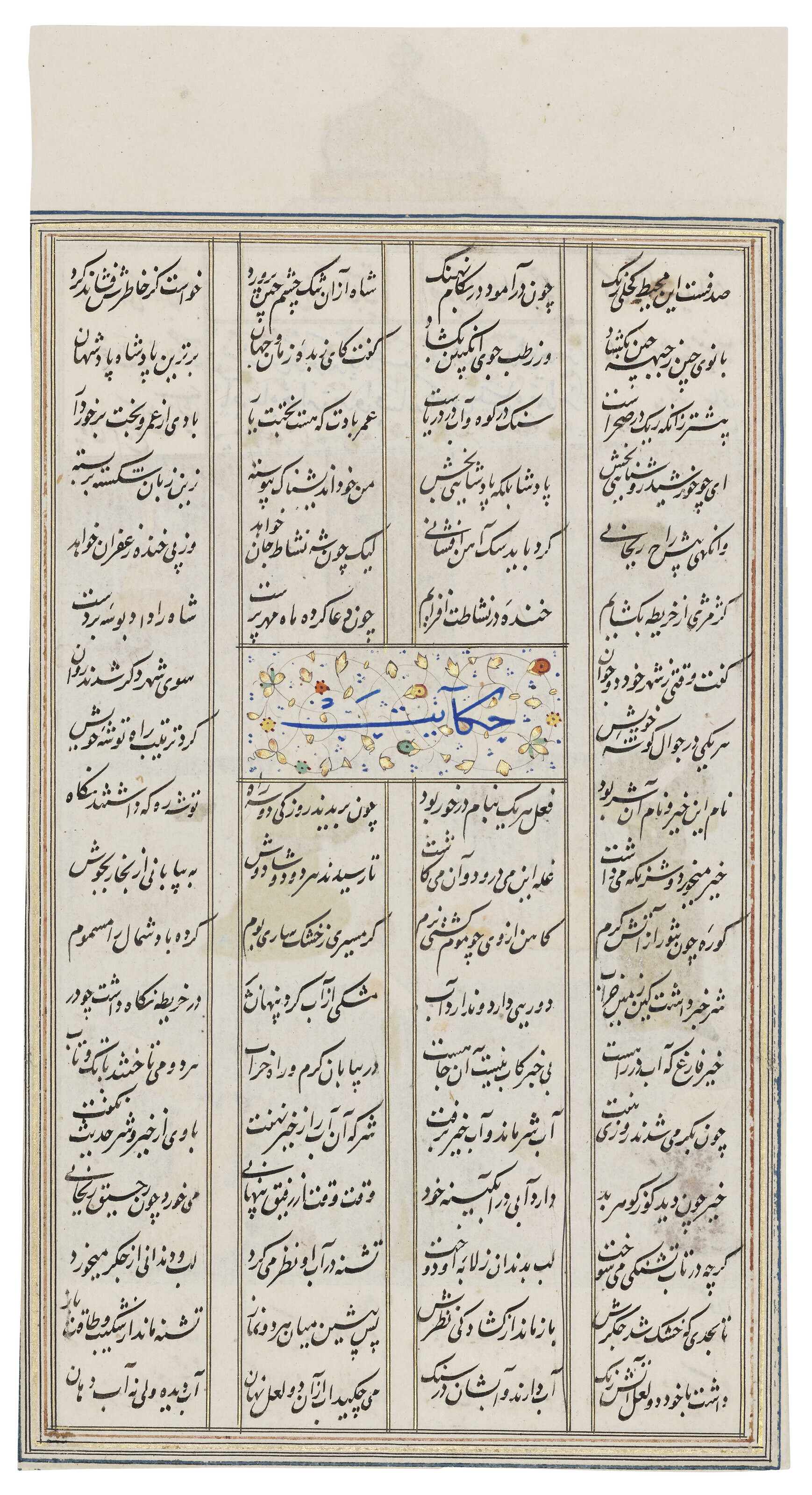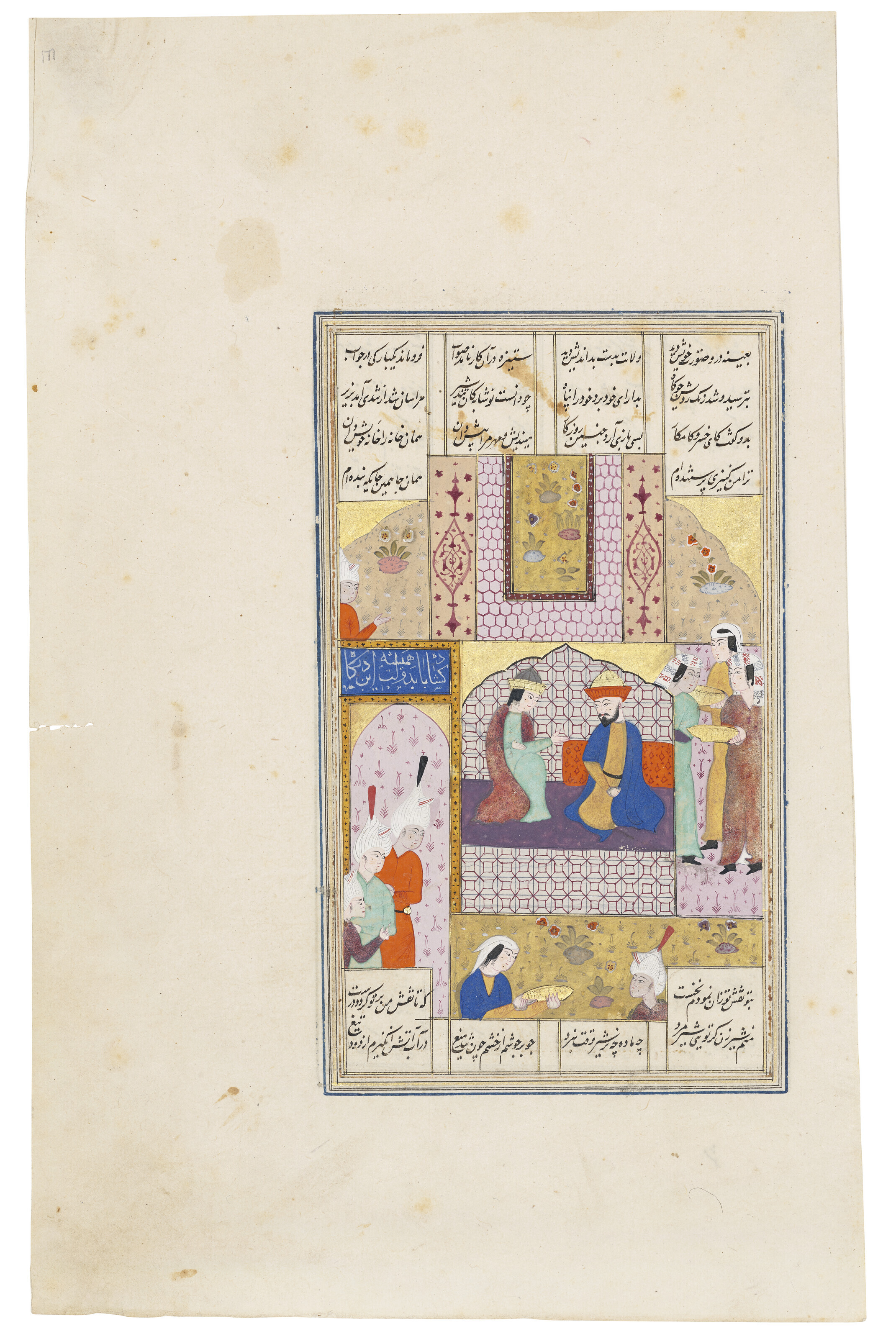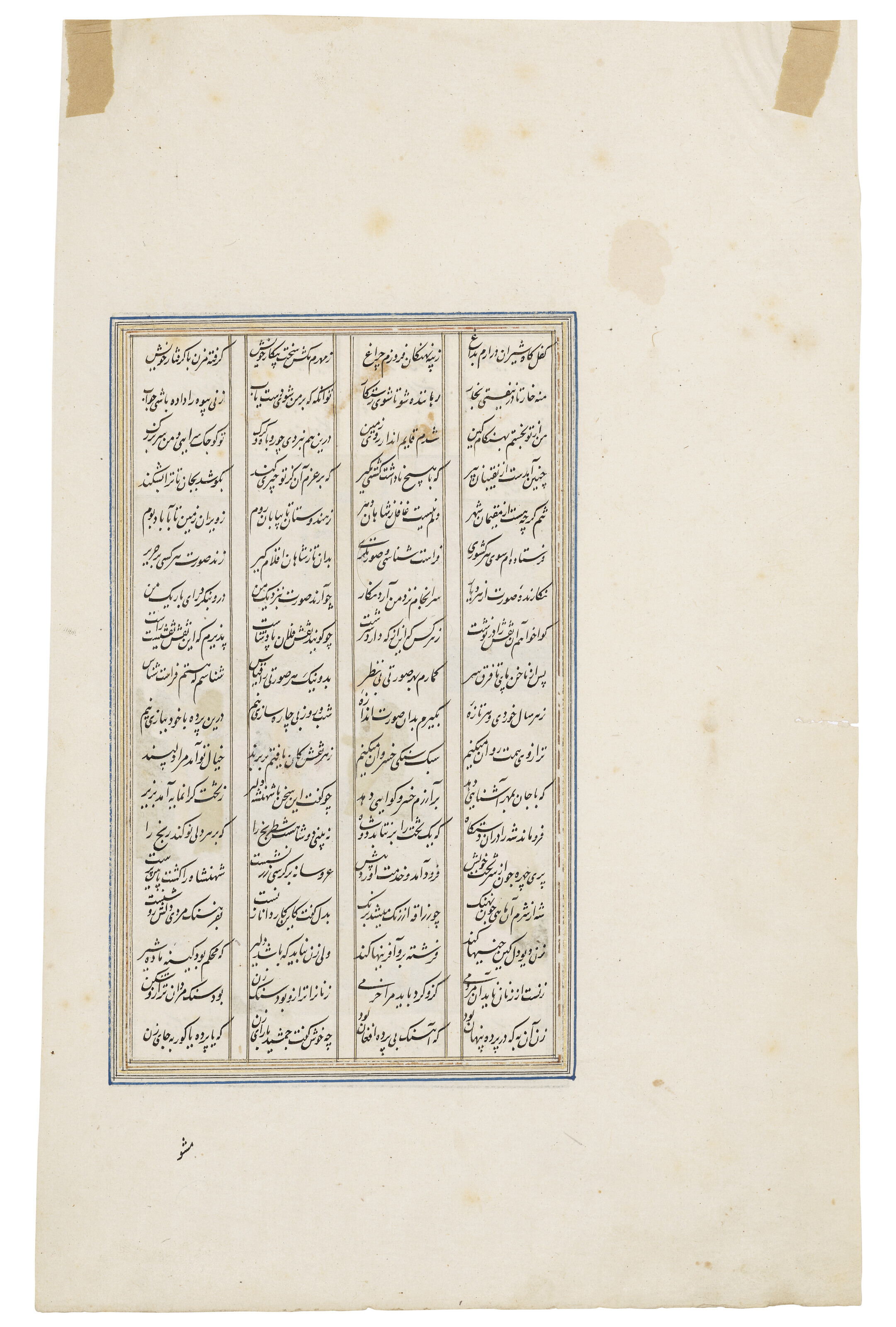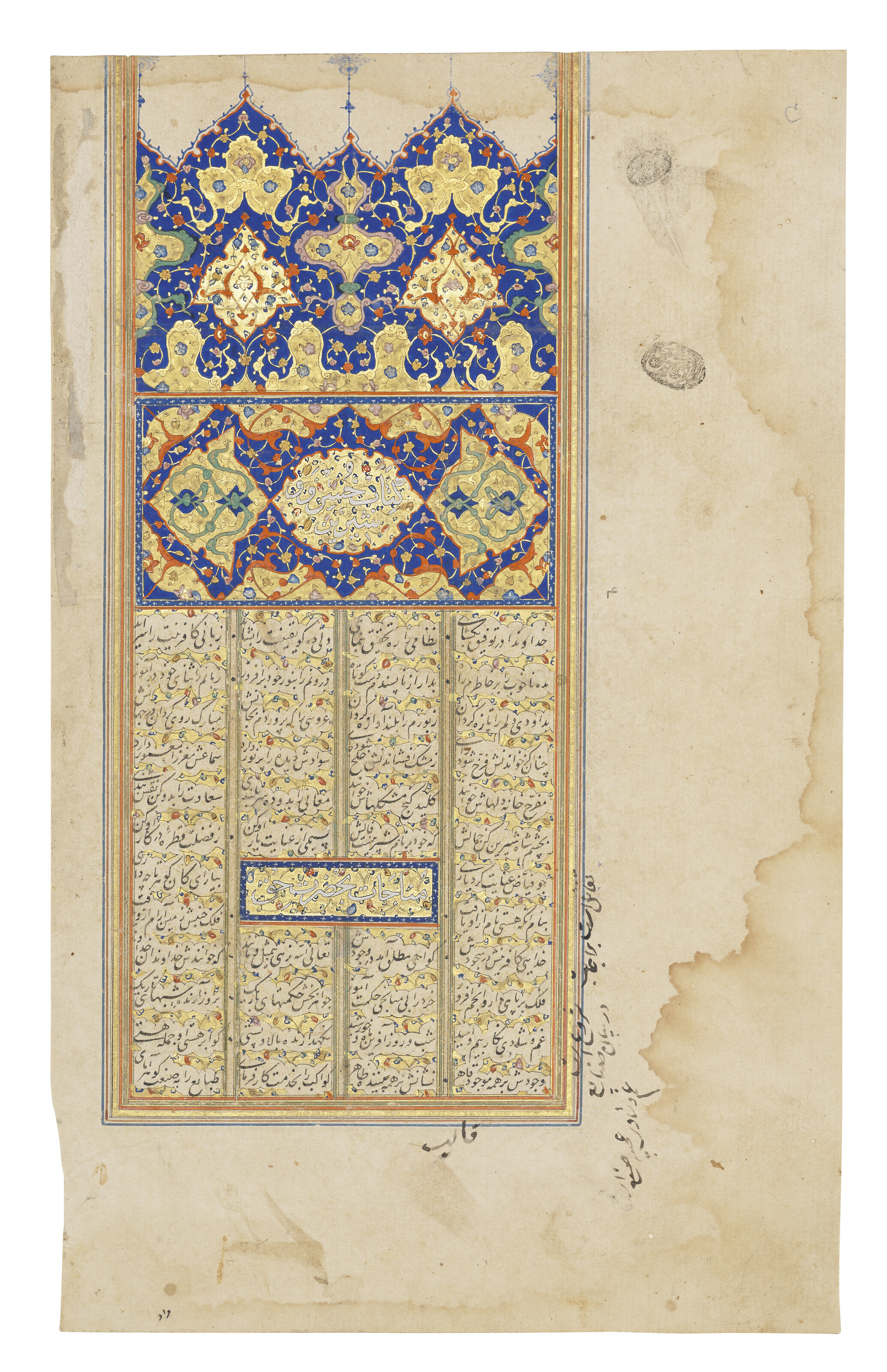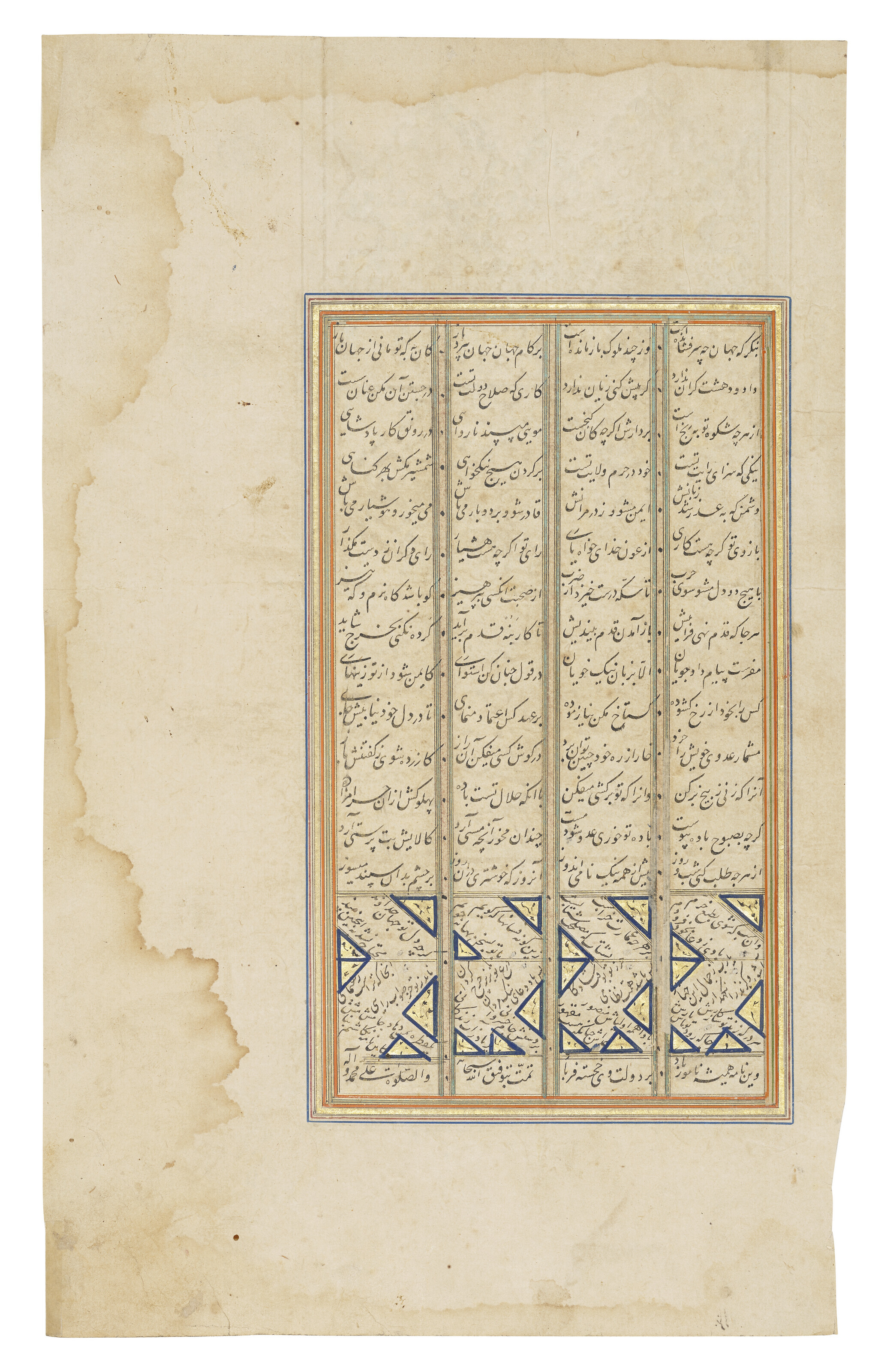- FIVE ILLUSTRATED FOLIOS AND AN ILLUMINATED TITLE PAGE FROM THE KHAMSA OF NIZAMI GANJAVI 1520
- Handicrafts and classics, miniature
- 19.7 * 30.5 cm
- PROBABLY SAFAVID SHIRAZ, IRAN, CIRCA 1520
Four folios from the Haft Paykar and one from Khusraw wa Shirin, together with an illuminated opening folio from Khusraw wa Shirin, the illustrated folios with opaque pigments heightened with gold on paper, four columns of black nasta'liq above and below, some with a chapter heading in blue nasta'liq against a floral ground above, the reverse with 14-18ll. black nasta'liq arranged in four columns and occasional chapter headings, set within gold and polychrome rules, three folios with margins cropped; the opening folio a Persian manuscript on paper, gold and polychrome illuminated headpiece surmounting 12ll. black nasta'liq arranged in four columns in clouds reserved against a gold ground, within gold and polychrome rules
Painting 7 1⁄8 x 3 7⁄8in. (18.3 x 9.8cm.); text panel 7 1⁄4 x 4 3⁄8in. (18.4 x 10.9cm.); folio 12 x 7 3⁄4in. (30.5 x 19.7cm.)
Estimation
£10,000
13,161 USD
-
£15,000
19,742 USD
Realized Price
£20,160
26,533 USD
61.28%
Artwork Description
The Khamsa, or quintet, of Nizami, completed in 1202, consists of five long narrative poems: the Makhzan-ol-Asrar; Khusraw wa Shirin; Layla wa Majnun; Iskandarnama; and Haft Peykar. The work was a popular subject for manuscript production and illumination.
This group of folios, though commercial in style, have densely filled scenes full of figures, architecture and lively plants, which B.W. Robinson comments are typical features of the transition from late Turkman to early Safavid painting (Adel Adamova & Manijeh Bayani, Persian Painting: The Arts of the Book and Portraiture, the Al-Sabah Collection, Kuwait, London, 2015, p.335). For a similar copy of the Khamsa dated 1513, see op.cit., cat.22, pp.335-65. A group of folios from a Khamsa from Shiraz circa 1510 was sold in these Rooms, 21 April 2016, lot 96.
This group comprises:
1. Bahram Gur in the Red Pavilion with the Slavic Princess, from the Haft Peykar
2. Bahram Gur in the Sandalwood pavilion with the Princess of Khwarazm, from the Haft Peykar
3. Bahram Gur placing the crown between the lions, from the Haft Peykar
4. Fitna carrying the cow on her back before Bahram Gur, from the Haft Peykar
5. Khusraw seated with Shirin, from Khusraw wa Shirin
6. An illuminated opening folio to Khusraw wa Shirin
This group of folios, though commercial in style, have densely filled scenes full of figures, architecture and lively plants, which B.W. Robinson comments are typical features of the transition from late Turkman to early Safavid painting (Adel Adamova & Manijeh Bayani, Persian Painting: The Arts of the Book and Portraiture, the Al-Sabah Collection, Kuwait, London, 2015, p.335). For a similar copy of the Khamsa dated 1513, see op.cit., cat.22, pp.335-65. A group of folios from a Khamsa from Shiraz circa 1510 was sold in these Rooms, 21 April 2016, lot 96.
This group comprises:
1. Bahram Gur in the Red Pavilion with the Slavic Princess, from the Haft Peykar
2. Bahram Gur in the Sandalwood pavilion with the Princess of Khwarazm, from the Haft Peykar
3. Bahram Gur placing the crown between the lions, from the Haft Peykar
4. Fitna carrying the cow on her back before Bahram Gur, from the Haft Peykar
5. Khusraw seated with Shirin, from Khusraw wa Shirin
6. An illuminated opening folio to Khusraw wa Shirin
More lots by Unknown Artist
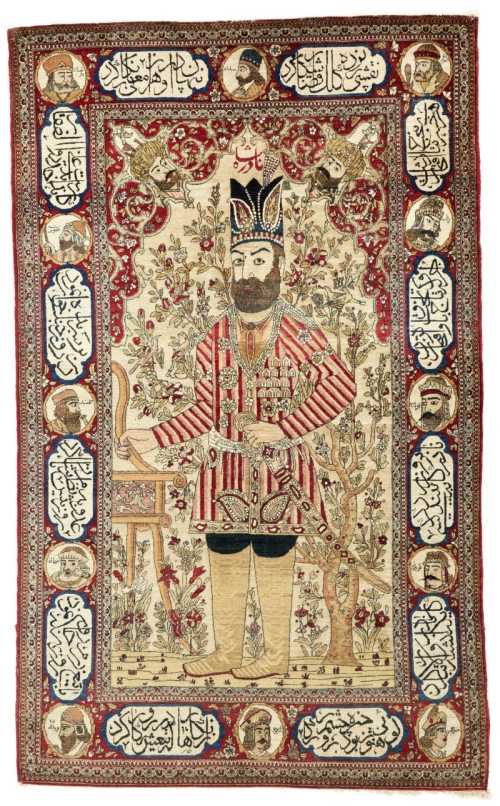
An Isfahan pictorial rug, Central Persia, circa 1910
Estimation
£4,000
5,236 USD
-
£6,000
7,853 USD
Realized Price
£5,670
7,421 USD
13.4%
Sale Date
Sotheby's
-
30 March 2022

A gold medal commemorating the coronation of Muhammad Reza Shah and Queen Farah
Estimation
£100
132 USD
-
£200
263 USD
Realized Price
£160
211 USD
6.667%
Sell at
Sale Date
Rosebery's Auction
-
1 April 2022
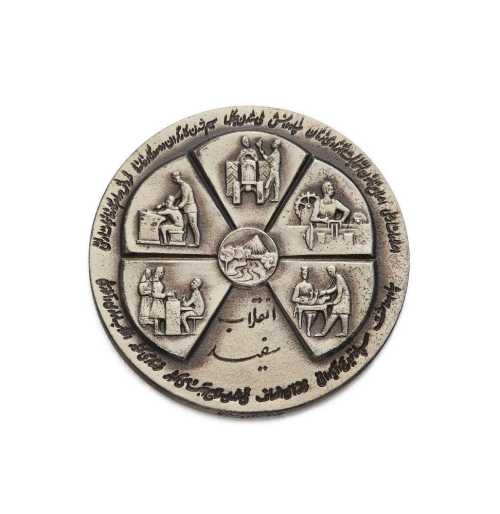
A silver memorial medal of the White Revolution, Muhammad Reza Shah, 1967
Estimation
£200
263 USD
-
£300
395 USD
Realized Price
£170
224 USD
32%
Sell at
Sale Date
Rosebery's Auction
-
1 April 2022
Realized Price
67,245 USD
Min Estimate
35,481 USD
Max Estimate
53,247 USD
Average Artwork Worth
+83.63%
Average Growth of Artwork Worth
Sales Performance Against Estimates
Average & Median Sold Lot Value
2021 - 2025
Performance vs. Estimate
2021 - 2025
Sell-through Rate
2021 - 2025
Similar Artworks
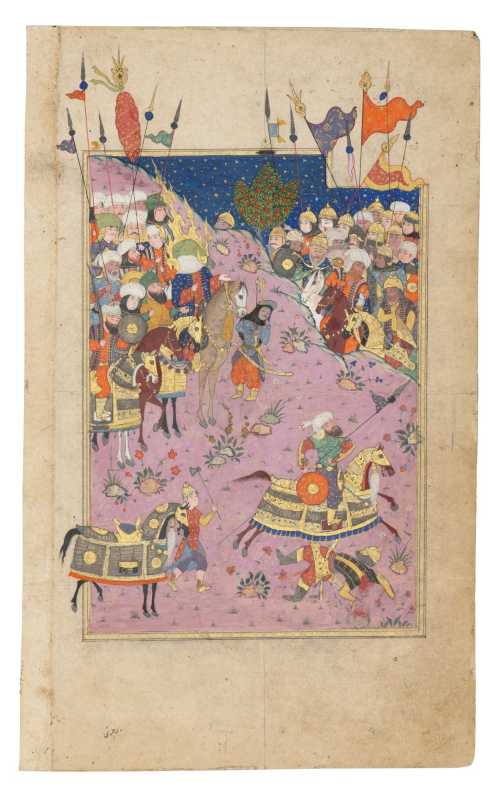
A SCENE FROM THE BATTLE OF KARBALA
Estimation
£6,000
7,897 USD
-
£8,000
10,529 USD
Realized Price
£22,680
29,850 USD
224%
Sell at
Sale Date
Christie's
-
31 March 2022
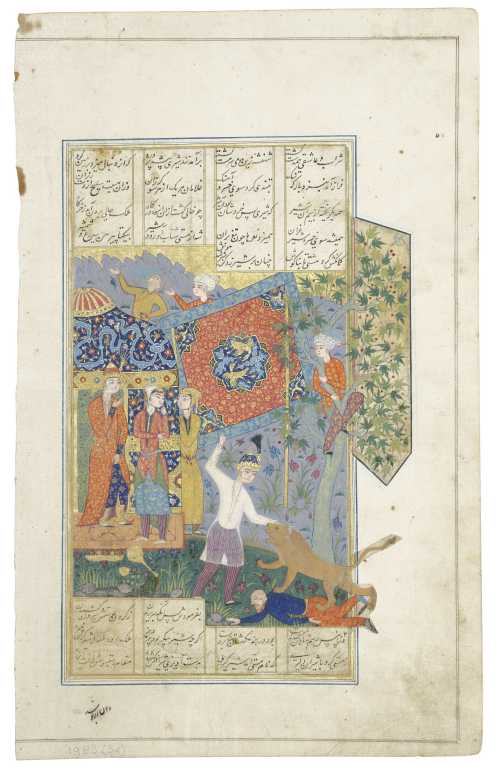
KHUSRAW KILLS THE LION WITH HIS FIST
Estimation
£6,000
7,897 USD
-
£8,000
10,529 USD
Realized Price
£20,160
26,533 USD
188%
Sell at
Sale Date
Christie's
-
31 March 2022
